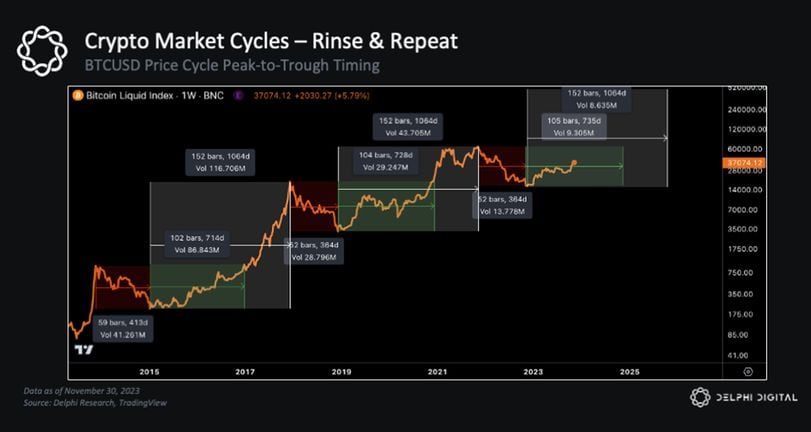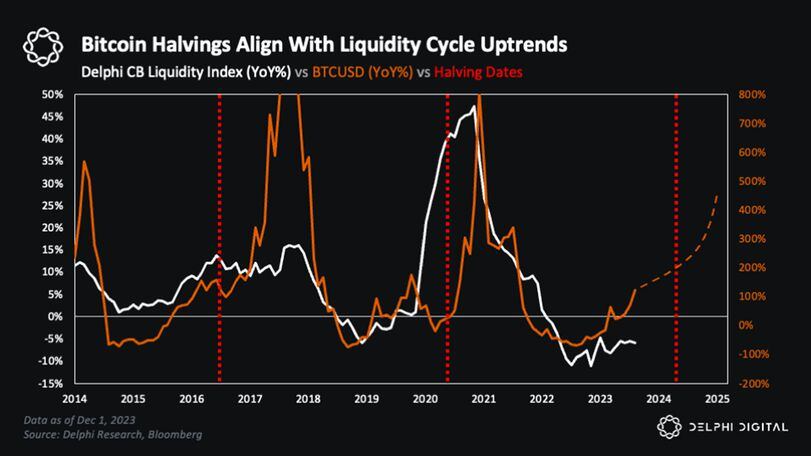History shows there’s likely a bright year ahead for BTC’s price.
The crypto market may seem like a foreign world to many, with no real rhyme or reason for how it trades.
Just like traditional markets, though, crypto goes through its own cycles – and these price cycles are remarkably consistent, including their timing between peak-to-trough bottoms, price recoveries and subsequent rallies to new cycle highs.
You’re reading Crypto Long & Short, our weekly newsletter featuring insights, news and analysis for the professional investor. Sign up here to get it in your inbox every Wednesday.
We believe we’re in the early stages of anew cycle. Using bitcoin (BTC) as our benchmark, here’s the typical structure of a crypto market cycle:
-
BTC’s price peaks at a new all-time high.
-
BTC then suffers a painful 80% or so drawdown.
-
The price eventually bottoms almost exactly one year after the prior cycle’s high.
-
BTC starts to recover and takes about two years to reach a new all-time high.
-
BTC continues to rally for another year before topping out at its next cycle high.
-
Then the cycle repeats.
The last few cycles have followed this playbook to a T.

The consistency of these cycles isn’t by coincidence. It’s driven by bigger, more powerful macro trends – and one that lies at the very heart of bitcoin’s value proposition.
Bitcoin is not an inflation hedge in the way many believe it to be. Bitcoin is not a hedge on the Consumer Price Index, or CPI. It’s a hedge against currency debasement.
That distinction is important because currency debasement is driven by monetary inflation and the expansion of central bank balance sheets. In essence, BTC is of the most leveraged bets on an expansionary liquidity environment.

Bitcoin halvings aren’t the primary catalyst for BTC bull markets – liquidity cycle uptrends are. It just so happens that each halving has lined up with an expansionary liquidity environment. The next halving is expected to occur in April 2024, which once again looks to be right on cue.
That’s not to say the Halving isn’t important – it’s a strong narrative that can certainly pour fuel on a bullish uptrend, especially if we see a spot BTC ETF approved ahead of time given liquidity upcycles tend to turbocharge fund flows.
BTC’s Promising Path Ahead
Bitcoin’s price bottomed in November 2022 – almost exactly one year after its last cycle peak. If BTC follows its historical playbook, that would imply a new all-time high by the fourth quarter of 2024 – and its next cycle peak roughly a year after that.
Wenoted back in the fourth quarter of 2022 that last year’s downtrend in global liquidity appeared to be bottoming, putting BTC’s price bottom in the rearview. The subsequent rebound in central bank liquidity has been a key support for the recovery in risk assets this year – especially crypto.
And we expect these trends to continue. Looking out over the next 12 to 18 months, we expect central bank balance sheets to continue expanding – largely because they’ll have to.
Many of the world’s largest economies are saddled with huge debt burdens – and here in the U.S., fiscal deficits are only expected to get worse (and that’s without a recession). Larger deficits mean more debt issuance, which eventually means more Federal Reserve support.
That is unless the relationship in this chart – which shows total U.S. public debt versus Fed total assets – decouples drastically.
Link: https://www.coindesk.com/markets/2023/12/06/bitcoin-and-the-predictability-of-crypto-market-cycles/?utm_source=pocket_saves
Source: https://www.coindesk.com




















